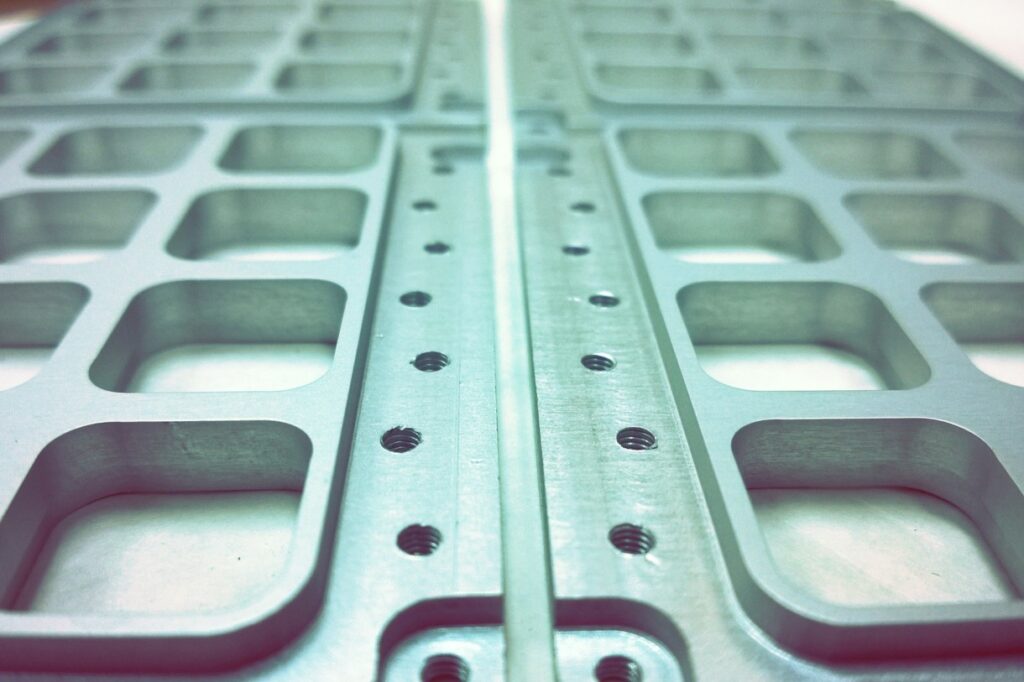Anodizing aluminum sounds complicated, and it undoubtedly requires know-how. However, the process is simple for an experienced CNC machine shop. Understand how it works and the benefits of anodizing as a finish for aluminum.
Anodizing aluminum is a post-process coating applied to machined and cast parts and prototypes. The anodizing process has been around since the 1920s. Aluminum is still one of the most widely used metals. Engineers favor this material and its many alloys because of its versatility and lightweight, corrosion-resistant properties. Anodizing aluminum makes it even more helpful.
Untreated aluminum is excellent for many applications, but it has low wear resistance and can get damaged by environmental exposure. Some parts and structures eventually corrode, but anodized aluminum lasts longer.
Understanding how anodizing aluminum works is essential to reaping the many benefits. Here is everything you need to know.
Table of Contents
How Does Anodizing Aluminum Work?
The Aluminum Anodizing Process Explained
Step 2: Pre-Treating the Parts
Anodizing vs. Powder Coating: The Primary Differences
Is Aluminum the Only Material That Can Be Anodized?
The Eight Benefits of Anodizing Aluminum and Other Materials
#7. Lower Fabrication and Assembly Costs
What Is Anodized Aluminum?
Aluminum anodizing uses a chemical scientific process to protect the material from wear and tear. It also improves the appearance of aluminum surfaces on exposed parts. The CNC machining industry began using this technique around 1923 when the first commercial application became mainstream.
This complex electrochemical technique creates an aluminum oxide on the part’s surface. The oxidation helps fortify each component before assembly. Products perform as anodes in electrolytic cells using sulfuric acid to instigate a chemical reaction. Hence, aluminum anodizing is sometimes called different names based on the processes required.
How Does Anodizing Aluminum Work?
Anodizing aluminum uses an electrolytic cell and abrasive chemicals to change metal surface properties. Most experts follow a multi-step technique to ensure the highest quality outcomes. Usually, the process works like this:
- Fill a tank with an electrolyte. Typically, the tank is large enough to fit various sized aluminum pieces or several components at once.
- Suspend the aluminum parts inside the tank to expose them to the electrolytes. Some components may require prolonged exposure times.
- Place aluminum plates into the electrolytic bath. This completes the circuit between the anode and cathode.
Anodizing aluminum requires a consistent power source, top-notch raw materials, and potent chemicals. The aluminum component connects to a positive terminal, and the metal plate attaches to a negative terminal. The required electrical current cannot pass through the materials without a strong battery.
DID YOU KNOW: Experts can adjust anodizing times to customize aluminum oxide layer thickness by changing the duration of electrical current exposure.
The Aluminum Anodizing Process Explained
Most CNC companies still use sulfuric acid baths as part of the process. The reason is that this technique is effective and efficient for many applications. Meanwhile, advanced facilities can utilize a few new features to enhance the outcomes. Modern shops often use techniques that improve surface quality, appearance, and functionality.
While the previous methodologies were relatively complex, today’s aluminum anodizing process is even more technical. Most of the time, it consists of these five crucial steps:

We offer fast, high-quality, tailored PROTOTYPING solutions for leading companies in a wide range of industries.
superior Rapid PROTOTYPING
Step 1: Cleaning the Material
CNC machinists begin anodizing aluminum by washing the products to remove surface debris. Generally, they use alkaline or acidic agents to degrease the parts. This exposes its natural properties for the next steps.
Step 2: Pre-Treating the Parts
This step involves addressing any apparent imperfections in the material’s surface. CNC operators can create a clean and smooth finish through two different techniques – etching and brightening.
- Etching: Prepare metals for anodizing while creating a smooth matte finish with etching. Machinists remove imperfections with a proprietary solution of heated sodium hydroxide.
- Brightening: Workers can clear away heavy metal residues and surface debris from the cleaning phase. They typically use a combination of phosphoric and nitric acids to smooth the material and eliminate flaws.
Here is where teams can determine gloss levels and other details before anodizing aluminum or other materials. Ask your crew for more information on creating prototypes before the inspection.
Step 3: Anodizing Aluminum
Step three begins after step two ends. Products ready for anodizing go into an electrolytic tank where experts expose them to various sulfuric acids and controlled electrical currents. Other chemicals might include:
- Phosphoric acid
- Borate
- Chromic Acid
- Tartrate
- Organic Acids
Each acid type renders different results based on the chosen technique and material aspects. Unfortunately, this is only the start of the aluminum anodizing process. CNC machine shops must continue to the next steps for a workable finish.
Step 4: Colorizing the Metal
Coloring anodized aluminum is relatively straightforward. However, the colorizing process can depend on several factors, including the material grade and finish. The two most commonly preferred approaches are metal dyeing and electro coloring.
- Dyeing: Experts can change the color of aluminum by filling surface pores with a thick layer of metal dye. This technique enhances durability and is perfect for applying dark or light shades.
- Electrocoloring: This method is best for darker colors. It introduces inorganic metallic salts to the electrolytic solution to change the shade by filling in surface pores.
Step 5: Seal the Surface
The final step is critical because it makes the work permanent. Sealing also plays a crucial role in anodizing aluminum because it prevents leakage and corrosion problems. Experts can choose between hot, cold, or combination sealants for maximum efficiency.
CNC machine shops usually select a specific type of anodizing for aluminum parts. That means they can customize outcomes based on various aspects. Let’s explore the different styles now.
Types of Anodizing
Anodizing aluminum requires keen attention to detail. For example, the process type typically depends on material thickness and aluminum hydroxide layering. There are two different anodizing methods as a result.
Type #1: Hard Anodizing
Hard aluminum anodizing is perfect for projects that require additional corrosion resistance and protection from various elements. Automotive manufacturing, marine parts fabrication, and food industry production are the most common applications. However, the medical and electronics industries also prefer this method.
NOTE: According to ISO 10074:2017, oxidation coating thickness must stay between 25µm and 50µm for most commercial products.
Type #2: Decorative Anodizing
Decorative aluminum anodizing creates an attractive aesthetic with a tailored finish. It can also help shield the surface from exposure to different elements. Anodizing aluminum for decorative purposes provides more design freedom while still offering the same benefits as hard anodizing.
NOTE: According to ISO 7599:2018, oxidation coating thickness should remain between 5µm to 25µm for best results.
Many people mistake decorative anodizing for powder coating, mainly when experts use electrocoloing techniques. However, the final puzzle piece consists of learning the difference between aluminum anodizing and powder coating. Let’s take a closer look for a detailed comparison.
Anodizing vs. Powder Coating: The Primary Differences
Anodizing aluminum isn’t the same as powder coating aluminum. Powder-coated metals go through a unique fabrication and finishing process. Technicians use the procedure to create specific designs for different applications. In other words, you don’t get the same outcomes.
Aluminum powder coating services consist of various surface treatments that don’t involve electrolytic elements. The method is perfect for both industrial and decorative purposes because it provides a customized aesthetic while enhancing the product’s durability.
For most projects, however, anodizing is the best option. Here are the top three reasons why:
- Superior Finish: Inorganic compounds create a smoother finish than their organic counterparts.
- Light Sensitive: Anodized aluminum reacts differently to the light, with a brighter sheen than powder-coated surfaces.
- Reliable Adhesion: Anodizing metals means longer-lasting colors that fade more slowly over time.
Want to know more about the pros and cons of anodizing aluminum versus powder coating it? Talk to your CNC machining team to discuss the prototyping possibilities.

We offer fast, high-quality, tailored PROTOTYPING solutions for leading companies in a wide range of industries.
superior Rapid PROTOTYPING
Is Aluminum the Only Material That Can Be Anodized?
What materials can be anodized, and which ones should you use alternative methods? That’s one of the questions you can ask your production team. In the meantime, this is what you need to know.
Aluminum isn’t the only metal suitable for anodizing. Expert fabrication companies can also process other materials, including plastics and synthetic polycarbonates. Advanced prototyping facilities typically experiment with various textiles such as:
- Zinc
- Magnesium
- Titanium
- Tantalum
- Niobium
- Zirconium
- Hafnium
Each material serves a different purpose in modern products, so that the anodizing technique can vary from one project to another. Rapid prototyping and 3D printing services are perfect for testing design elements and improving the functionality of parts. Both options can also ensure less stressful inspections and guaranteed distribution approvals.
The Eight Benefits of Anodizing Aluminum and Other Materials
Anodizing aluminum is supposed to serve one purpose – to increase the oxide thickness on the surface of each part. That alone provides countless benefits to product designers and engineers in every industry. Fortunately, an oxide thickness enhancement isn’t the only benefit. Below are the other advantages of aluminum anodizing:
#1. Increased Hardness
Aluminum oxides form layers on the material’s surface to help guard it against corrosion and elemental damages. Moreover, anodized oxides are exceptionally hard and exceedingly durable. Some applications can also make metals almost as durable as diamonds (based on the Mohr’s hardness scale).
#2. Customized Aesthetics
The outcome of your project depends on which anodizing method you choose. For example, decorative applications can withstand thicker oxidation levels and more robust colorizing. However, practical parts might require tailored layering to achieve a good design that’s still attractive.
#3. Built-In Primer
Anodizing aluminum provides an excellent primer for additional paint coats and custom colorizing. It’s the perfect process for tailored branding and experimental designs, with exclusive pigments available to fill pores and create a smooth, scratch-resistant finish.
#4. More Vivid Hues
Thick aluminum oxide layers mean more receptive surfaces for paints, dyes, and electro-coloring particles. Pigments dive deep into the pores, adhering to the materials and creating a longer-lasting outcome. The durability also enhanced color brightness to reveal dramatic shades for packaging and branding.
#5. Increased Insulation
Aluminum oxides are poor conductors of electricity. Therefore, anodizing aluminum enhances insulation with thick, robust layering. This can help control internal and external temperatures while managing physical reactions between clashing components.
#6. Product Uniformity
Anodizing typically eliminates surface imperfections to produce aesthetically pleasing outcomes. Meanwhile, none of that matters if it’s only intermittent. High-quality aluminum anodizing services offer production uniformity with a smooth, flawless finish. This helps speed up production and increase profits while reducing waste.
#7. Lower Fabrication and Assembly Costs
It costs less to finish an anodized metal than most other materials. Further, anodizing textiles means more long-term value and less direct maintenance. Experts can create and assemble parts more efficiently when not worried about damaging the surface.
#8. Safe and Stable
This metal fabrication process is not harmful to humans. It’s chemically stable instead, which means it won’t decompose and is non-toxic when discarded. Anodizing can also increase the melting point of aluminum, making it safer for heavy-duty applications.
To get a full scope of all anodizing advantages, consult a CNC machine shop with prototyping expertise.
Conclusion
Anodizing aluminum reinforces naturally occurring features while providing additional properties suitable for mass production. The technique can help prepare parts for manufacturing and distribution, plus it can improve aesthetics and reduce machining times. This non-toxic metal finishing method is eco-friendly, cost-effective, and perfect for countless applications.
The process is technical and complicated, so it undoubtedly requires skill. However, aluminum anodizing is simple for an experienced CNC machine shop. Understanding how it works and learning about the benefits can fortify projects in every category. The methods improve outcomes without sacrificing quality or ignoring ISO regulations.
 About the Author
About the Author
James Murphy is the founder and CEO of HLH Rapid – a hybrid CNC machine shop fusing Western service and quality with Eurasian industry influences for over 14 years. His advanced enterprise uncovers cost-effective rapid injection molding techniques to remain unmatched by industry competitors. Murphy’s full-service fabrication and manufacturing methods span six dedicated zones, from 3D printing and vacuum casting to sheet metal prototyping and project management. His expertise also includes high-efficiency machining within strict yet volatile markets.
Murphy earned an MBA after becoming inspired by his father’s hands-on craftsmanship. As a budding entrepreneur, he taught English and studied Chinese to pursue pioneering objectives. His groundbreaking approach helps build the future by providing well-rounded manufacturing services to innovative Western businesses. When he’s not offering upscale RP and CNC, James enjoys art-house movies, Thai boxing, and spending time with his growing family.


